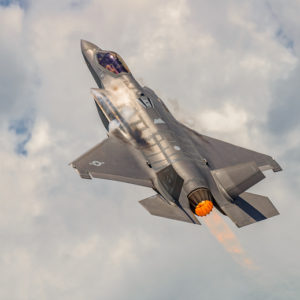Conservatives are supposed to be . . . conservative. Especially with the taxpayers’ money.
So it’s odd to hear — and read about — conservatives defending the F-35 fighter program, which has cost taxpayers more money than any other airplane.
So far. With more to come.
Each one costs about $100 million dollars — with the total bill for the program expected to exceed $1.7 trillion dollars. Which makes the money spent by the Japanese on the largest — and most useless — battleships ever launched, the Yamato and Mushasi, seem like a deal.
These super dreadnoughts were launched in the same month — December, 1941 — that Japanese carrier aircraft sank America’s battleships at Pearl Harbor, establishing the obsolescence of the battleship even as the newest ones were piped into service.
Is the F-35 the super dreadnought of our time? The Heritage Foundation apparently thinks so. It has been defending the most over-budget and under-performing airplane the military has ever flown — for reasons known only to the emperor.
The plane is so expensive the country can’t afford to lose any. Or even fly them. It costs $32,500 per hour to keep one in the air, according to the Government Accountability Office — as compared with $25,500 for the F-16.
Which might be justified if the plane flew.
But it’s so complex — a kind of flying supercomputer — that it’s incredibly fragile and temperamental. Popular Mechanics reported it has trouble flying in the rain. Lightning fritzes it; high-speed operation tends to damage it.
It will also likely have a shorter useful service life for this reason than simpler (and far cheaper to operate) aircraft like the B-52 Stratofortress, which dates back to the mid-1950s and which is still in active, front-line service.
Not just the program, either. The actual Eisenhower-era planes — which are crewed by pilots who weren’t born when they were built.
By way of cost comparison, a B-52 costs about $14 billion to make — amortized over 50 years and counting. That’s almost as cheap as a Camry —and the B-52 is a lot cheaper to fly and can fly in the rain and fast because it’s more rugged and durable.
Because it’s not a flying supercomputer that you throw away like an out-of-date cell phone after just a couple of years.
Speaking of things out-of-date…
It may well be the case that manned combat aircraft in general are the battleships of our time, or the near-future time. It is already the case that the capabilities of military aircraft exceed the physical capabilities of human pilots, most especially as regards the human pilot’s ability to withstand “G” forces during high-performance maneuvers. A pressurized flight suit can only compensate to a certain degree.
Which is one of the reasons why the Pentagon has been shifting over to unpiloted drone aircraft, which aren’t limited by human limitations. Drones can execute high G maneuvers that would injure or even kill a human pilot, who in any case could not control the aircraft during such maneuvers.
They can also stay aloft for many more hours, without fatiguing the pilot they haven’t got. Drones also have the advantage of being inherently disposable for that reason, too.
There is also the economic reason.
Drones cost a fraction of the cost of a manned aircraft, in part because they don’t have to be as large (to accommodate a man) nor equipped with the equipment necessary to keep a man alive, including AC and heat and a pressurized cockpit.
They can project power just as effectively, far more cheaply — in dollars and lives.
The F-35, meanwhile, is not only hugely expensive — it is embarrassingly over-budget. In addition to being the costliest weapon system ever, it is projected to cost at least $10 billion more than it was expected to cost over the next five years alone.
Bloomberg News just broke the story via a leaked “For Official Use Only” Pentagon document which estimates that $88 billion will be needed for “research and development, jet procurement, operations and maintenance and military construction…” which the Department of Defense (DoD) had previously stated would “only” cost taxpayers $78 billion.
The Heritage piece describes this as “cost effective.” You can almost feel the earth moving over Ronald Reagan’s grave as his spinning perturbs it.
No one has yet estimated what it will cost the American taxpayer over the next 10 years. By which time, the F-35 will likely be as obsolete as the Yamato was on the day Japanese carriers sank the battleships anchored at Pearl Harbor.
It will certainly be a relic by 2077 — the projected terminal year for the F-35 program.
After the story about the program’s appalling cost-overruns broke, the DoD issued an insouciant statement via spokeswoman Brandi Schiff that “As the five-year numbers are estimates, we don’t have a reaction.”
Probably because the DoD won’t be paying the bill. It’ll be the American taxpayer who gets it.
It’d be more cost-effective to send a barge filled with gold bars to the bottom of the East China Sea, where it will do the American taxpayers about as much good as the largest, most expensive battleship ever built did for the Japanese.

